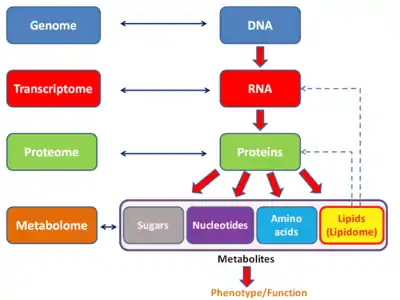

The lipidome refers to the totality of lipids in cells. Lipids are one of the four major molecular components of biological organisms, along with proteins, sugars and nucleic acids. Lipidome is a term coined in the context of omics in modern biology, within the field of lipidomics.[2] It can be studied using mass spectrometry and bioinformatics as well as traditional lab-based methods.[3][4] The lipidome of a cell can be subdivided into the membrane-lipidome and mediator-lipidome.[5]
The first cell lipidome to be published was that of a mouse macrophage in 2010.[6] The lipidome of the yeast Saccharomyces cerevisiae has been characterised with an estimated 95% coverage;[7] studies of the human lipidome are ongoing.[2][6] For example, the human plasma lipidome consist of almost 600 distinct molecular species.[8] Research suggests that the lipidome of an individual may be able to indicate cancer risks associated with dietary fats, particularly breast cancer.[9][10]
See also
References
- ↑ Klose, C; Surma, MA.; Gerl, MJ.; Meyenhofer, F; Shevchenko, A; Simons, K (April 2012). "Flexibility of a Eukaryotic Lipidome – Insights from Yeast Lipidomics". PLOS ONE. 7 (4): e35063. Bibcode:2012PLoSO...735063K. doi:10.1371/journal.pone.0035063. PMC 3329542. PMID 22529973.
- 1 2 Quehenberger O, Armando AM, Brown AH, et al. (November 2010). "Lipidomics reveals a remarkable diversity of lipids in human plasma". J. Lipid Res. 51 (11): 3299–305. doi:10.1194/jlr.M009449. PMC 2952570. PMID 20671299.
- ↑ Subramaniam S; Fahy E; Gupta S; Sud M; Byrnes R.W; Cotter D; Dinasarapu A.R; Maurya M.R (2011). "Bioinformatics and Systems Biology of the Lipidome". Chemical Reviews. 111 (10): 6452–6490. doi:10.1021/cr200295k. PMC 3383319. PMID 21939287.
- ↑ Seppänen-Laakso T, Oresic M (March 2009). "How to study lipidomes". J. Mol. Endocrinol. 42 (3): 185–90. doi:10.1677/JME-08-0150. PMID 19060177.
- ↑ "Lipidomics". BioSoft. Retrieved 7 May 2011.
- 1 2 "First Functioning 'Lipidome' of Mouse Macrophage Described". ScienceDaily. Retrieved 7 May 2011.
- ↑ Ejsing CS, Sampaio JL, Surendranath V, et al. (February 2009). "Global analysis of the yeast lipidome by quantitative shotgun mass spectrometry". Proc. Natl. Acad. Sci. U.S.A. 106 (7): 2136–41. doi:10.1073/pnas.0811700106. PMC 2650121. PMID 19174513.
- ↑ Quehenberger, Oswald; Dennis, Edward A. (2011-11-10). "The human plasma lipidome". The New England Journal of Medicine. 365 (19): 1812–1823. doi:10.1056/NEJMra1104901. ISSN 1533-4406. PMC 3412394. PMID 22070478.
- ↑ Bougnoux P, Hajjaji N, Couet C (2008). "The lipidome as a composite biomarker of the modifiable part of the risk of breast cancer". Prostaglandins Leukot. Essent. Fatty Acids. 79 (3–5): 93–6. doi:10.1016/j.plefa.2008.09.004. PMID 18930643.
- ↑ Bougnoux P, Giraudeau B, Couet C (March 2006). "Diet, cancer, and the lipidome". Cancer Epidemiol. Biomarkers Prev. 15 (3): 416–21. doi:10.1158/1055-9965.EPI-05-0546. PMC 2755770. PMID 16537692.
Further reading
- Mutch DM, Fauconnot L, Grigorov M, Fay LB (2006). "Putting the 'Ome' in lipid metabolism". Biotechnol Annu Rev. Biotechnology Annual Review. 12: 67–84. doi:10.1016/S1387-2656(06)12003-7. PMID 17045192.
- van der Meer-Janssen YP, van Galen J, Batenburg JJ, Helms JB (January 2010). "Lipids in host-pathogen interactions: pathogens exploit the complexity of the host cell lipidome". Prog. Lipid Res. 49 (1): 1–26. doi:10.1016/j.plipres.2009.07.003. PMC 7112618. PMID 19638285.
- Gaspar ML, Aregullin MA, Jesch SA, Nunez LR, Villa-García M, Henry SA (March 2007). "The emergence of yeast lipidomics". Biochim. Biophys. Acta. 1771 (3): 241–54. doi:10.1016/j.bbalip.2006.06.011. PMID 16920401.
External links